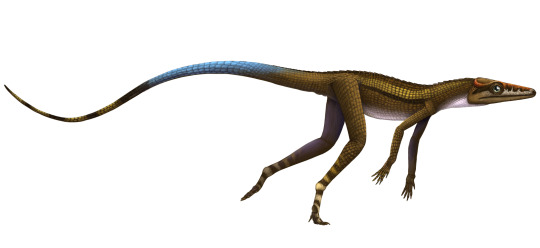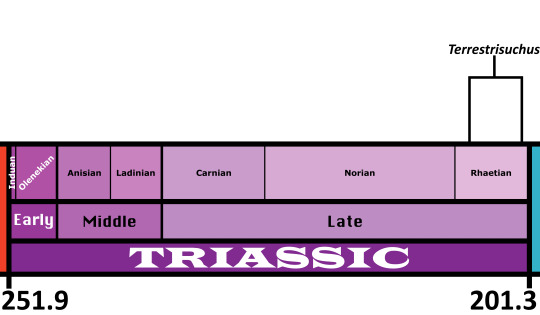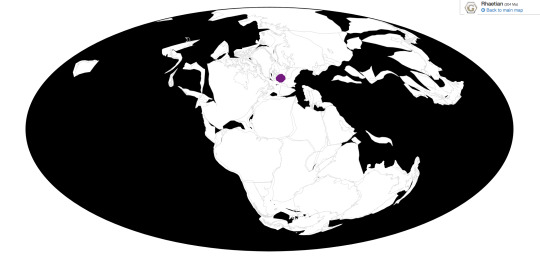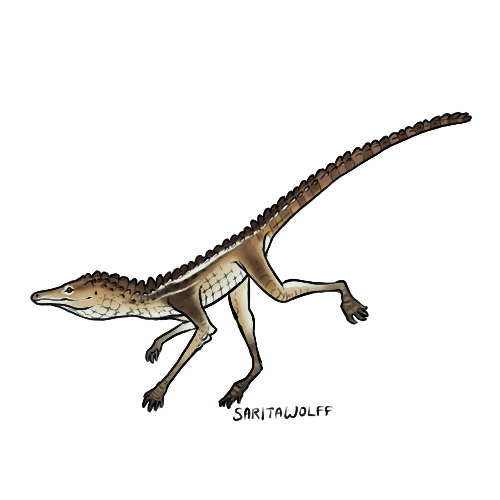#terrestrisuchus gracilis
Text
I really really need to practice my paleoart so I'm gonna try Archovember. (List of day prompts by @saritawolff is under the cut!) Day 1 is your choice, so I chose the leggiest of boys, Terrestrisuchus gracilis! Ignore the goofy eye, its been a while since I tried traditional art and I got too excited to erase the sketch lines and smudged it ;-;

T. gracilis lived during the Upper Triassic period, and contrary to its rather dinosaur-like appearance, it is actually one of the earliest known crocodylomorphs! Some estimates have it at about 1 meter (3 ft) long. It had long, thin legs and a thin frame. Its head was long and slender- perfect for catching tasty bugs! There seems to still be discourse over if it was a quadruped, a biped, or a mix of both (think like hadrosaurs!).


23 notes
·
View notes
Text
Terrestrisuchus gracilis

By Scott Reid
Etymology: Land Crocodile
First Described By: Crush, 1984
Classification: Biota, Archaea, Proteoarchaeota, Asgardarchaeota, Eukaryota, Neokaryota, Scotokaryota Opimoda, Podiata, Amorphea, Obazoa, Opisthokonta, Holozoa, Filozoa, Choanozoa, Animalia, Eumetazoa, Parahoxozoa, Bilateria, Nephrozoa, Deuterostomia, Chordata, Olfactores, Vertebrata, Craniata, Gnathostomata, Eugnathostomata, Osteichthyes, Sarcopterygii, Rhipidistia, Tetrapodomorpha, Eotetrapodiformes, Elpistostegalia, Stegocephalia, Tetrapoda, Reptiliomorpha, Amniota, Sauropsida, Eureptilia, Romeriida, Diapsida, Neodiapsida, Sauria, Archosauromorpha, Crocopoda, Archosauriformes, Eucrocopoda, Crurotarsi, Archosauria, Pseudosuchia, Suchia, Paracrocodylomorpha, Loricata Crocodylomorpha
Time and Place: Sometime around 205 to 203 million years ago, in the Rhaetian of the Late Triassic.

Terrestrisuchus is known from the Cromhall Quarry of England and the Pant-y-ffynnon Quarry of Wales

Physical Description: Terrestrisuchus was a fascinating early Crocodile relative, hailing from the Latest Triassic of the British Isles. Fascinating, in that, the closest relatives to proper Crocodiles we have from the Triassic are not the crocodile-esque Phytosaurs, nor the large land predator Rausichians, but these strange fast-moving reptiles from the end of the period. Looking weirdly like early dinosaur relatives, but crocodile-like, they were the most derived Pseudosuchians found in the Triassic and the earliest known Crocodylomorphs, the group of Pseudosuchians that would make it into the Jurassic and dominate the rest of the Mesozoic Era. Terrestrisuchus was nothing like a modern Crocodile in external appearance - small and thin, with a long flexible tail and long legs directly underneath its body. It was around 1 meter long, and only would have weighed up to 15 kilograms. It had a long, narrow head as well. It also had hindlimbs much longer than its forelimbs. They also ran on their toes, another trait that Terrestrisuchus shared with dinosaurs. That said, unlike dinosaurs, it would have been covered in tough scales - though what sorts, we can’t be sure, as skin impressions of Terrestrisuchus are not known.
Diet: Terrestrisuchus had small, needle-like teeth, indicating it was most likely insectivorous.
Behavior: Terrestrisuchus was, more likely than not, warm-blooded - making it a very quick and agile animal. The proportions of its front legs heavily indicates that it would have been able to run bipedally, allowing it to be even more agile and able to run after quick insects flying above its head. Terrestrisuchus running on its toes was even more helpful to this end, and its long tail would have served as a good counterbalance against the front-heaviness of its head and arms. Still, it probably couldn’t have used its hands for grabbing - at least, not as well as distant dinosaur cousins. The long snout of Terrestrisuchus would have been able to snap shut around a fast moving insects, helping to trap it quickly while on the move. It probably would have been able to gallop, at least somewhat, and thus could catch even faster insects in its environment. As an archosaur, it most likely would have taken care of its young, though the extent of this care is unknown.
Ecosystem: During the Triassic, Wales was an island in the tropical archipelago that was Europe. This island was occasionally hit by storms and was dotted by caves, which ended up being where the fossils were preserved. Terrestrisuchus lived alongside dinosaurs such as Pantydraco, the pseudosuchian Aenigmaspina, rhynchocephalians such as Clevosaurus and Diphydontosaurus, procolophonids, and the weird gliding Kuehneosaurus.
Other: Despite what you may read floating around online, it is not widely accepted that Terrestrisuchus is a juvenile of Saltoposuchus. The suggestion has only been made in a conference poster from 2003, and the two genera are separated both temporally and geographically.
Also shoutout to @deinonychusfloof because she studies Pant-y-ffynnon fauna!
~ By Meig Dickson and Henry Thomas
Sources Under the Cut
Benson, R. B. J., S. Brussatte. 2012. Prehistoric Life. London: Dorling Kindersley. 216.
Bronzati, M., F. C. Montefeltro, M. C. Langer. 2012. A species-level supertree of Crocodyliformes. Historical Biology 24 (6): 598 - 606.
Crush, P. J. 1984. A Late Upper Triassic Sphenosuchid Crocodilian from Wales. Palaeontology 27 (1): 131 - 157.
Fiorelli, L., J. O. Calvo. 2008. New remains of Notosuchus terrestris Woodward, 1896 (Crocodyliformes: Mesoeucrocodylia) from the Late Cretaceous of Neuquen, Patagonia, Argentina. Arquivos do Museu Nacional, Rio de Janeiro 66 (1): 83 - 124.
Irmis, R. B., S. J. Nesbitt, H.-D. Sues. 2014. Early Crocodylomorpha. Geological Society, London, Special Publications 379: 275 - 302.
Emily Keeble, pers. comm.
Keeble, E., Whiteside, D.I., Benton, M.J. 2018. The terrestrial fauna of the Late Triassic Pant-y-ffynnon Quarry fissures, South Wales, UK and a new species of Clevosaurus (Lepidosauria: Rhynchocephalia). Proceedings of the Geologists’ Association 129(2): 99-119.
Nesbitt, S. J. 2011. The early evolution of archosaurs: relationships and the origin of major clades. Bulletin of the American Museum of Natural History 352: 1 - 292.
Palmer, D., ed. 1999. The Marshall Illustrated Encyclopedia of Dinosaurs and Prehistoric Animals. London: Marshall Editions. 98.
Sertich, J. J. W., P. M. O’Connor. 2014. A new crocodyliform from the middle Cretaceous Galula Formation, southwestern Tanzania. Journal of Vertebrate Paleontology 24 (2): 576 - 596.
#terrestrisuchus#terrestrisuchus gracilis#sphenosuchian#pseudosuchian#triassic#triassic madness#triassic march madness#prehistoric life#paleontology
189 notes
·
View notes
Text

#Archovember Day 4 - Terrestrisuchus gracilis
Our first pseudosuchian on the list! Though certainly not the most impressive croc-relative out there, I wanted to include one of the small, agile pseudosuchians to show just how diverse this clade is (and also cause I wasn’t too happy with my Hesperosuchus from last year 😅)
Terrestrisuchus was about the size of a rabbit or domestic cat. It was entirely terrestrial, darting about in the undergrowth of the tropical islands that used to exist where southern Britain is now. It had long, upright limbs and was likely fast and agile, using it’s speed to chase down small reptiles and insects.
#my art#Terrestrisuchus#Terrestrisuchus gracilis#Archovember#Archovember2020#Dinovember#Dinovember2020#DrawDinovember#DrawDinovember2020#pseudosuchians#archosaurs#archosauromorphs#reptiles#SaritaDrawsPalaeo
6 notes
·
View notes